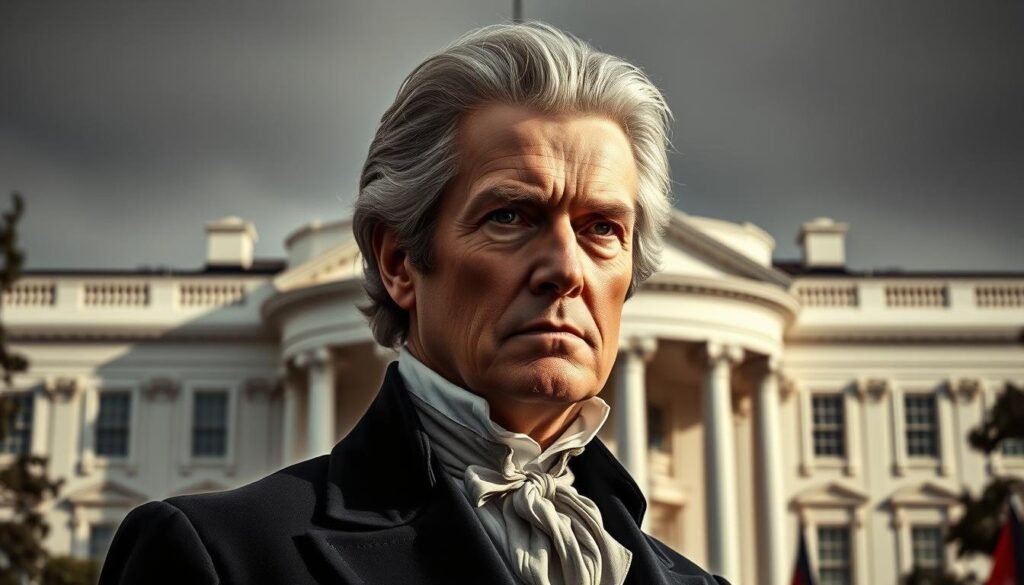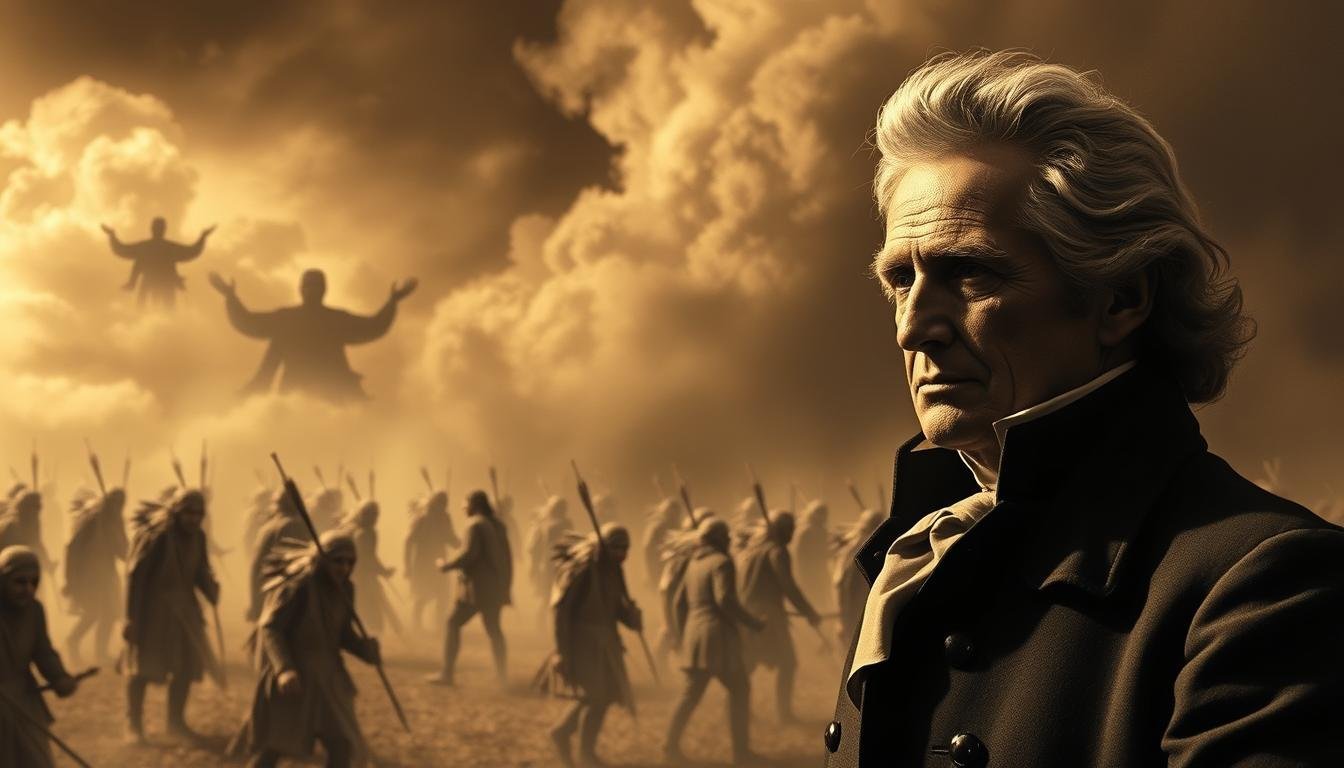Exploring the Darker Side of Andrew Jackson: Andrew Jackson’s presidency is not just about his big contributions to American history. It’s also filled with controversy and negative impacts that still affect us today.
His decisions during his time in office have had a lasting impact. They have shaped the country’s future in deep ways. As you explore his presidency, you’ll see how the historical context influenced his actions.
It’s important to understand the darker side of his presidency to truly understand American history. This article will take you through the challenging times of his leadership. We’ll look at the controversies and their lasting effects.
Contents
- 1 The Man Behind the Myth: Andrew Jackson’s Rise to Power
- 2 The Indian Removal Act and the Trail of Tears
- 3 What Bad Things Did Andrew Jackson Do As President: A Critical Examination
- 4 The Bank War and Economic Turmoil
- 5 Jackson’s Relationship with Slavery and Racial Policies
- 6 The Expansion of Executive Power
- 7 Conclusion: Exploring the Darker Side of Andrew Jackson
- 8 FAQ
- 8.1 What were the main controversies surrounding Andrew Jackson’s presidency?
- 8.2 What was the Indian Removal Act, and how did it affect Native American tribes?
- 8.3 What was the Bank War, and what were its consequences?
- 8.4 How did Andrew Jackson’s relationship with slavery impact his presidency?
- 8.5 What was the significance of Andrew Jackson’s expansion of executive power?
- 8.6 How is Andrew Jackson’s legacy viewed in modern America?
- 8.7 What can we learn from Andrew Jackson’s presidency about the complexities of leadership and power?
The Man Behind the Myth: Andrew Jackson’s Rise to Power
Andrew Jackson was known for standing up for the common man. His rise to power showed both his populist side and early signs of authoritarianism. You will see how his charm and appeal to the masses hid some of his darker traits.
Jackson’s Populist Appeal
Andrew Jackson was seen as a hero and a fighter for the common man. His leadership style connected with many who felt left out by the elite. His down-to-earth, straightforward politics were a big change from the aristocratic leaders of his time.
The table below shows what made Jackson popular:
| Factor | Description | Impact |
|---|---|---|
| War Hero | Jackson’s military service and victories | Boosted his national reputation |
| Common Man | Identification with ordinary Americans | Increased his popularity among the masses |
| Anti-Elitism | Criticism of the political establishment | Resonated with those feeling disenfranchised |
Early Warning Signs of Authoritarian Tendencies
Despite his appeal, Jackson’s presidency showed early signs of authoritarianism. His strong will and disregard for limits on his power worried many.
Jackson’s leadership and decisions during his rise set the stage for both his popularity and the controversies that followed.
The Indian Removal Act and the Trail of Tears
Andrew Jackson’s presidency saw a dark chapter in American history with the Indian Removal Act. This act aimed to move thousands of Native Americans from their lands to the west of the Mississippi River.
The Indian Removal Act of 1830 was a highly debated policy. It forced the relocation of the Cherokee, Muscoggee (Creek), Seminole, Chickasaw, and Choctaw tribes. The Cherokee Nation fought hard against this, leading to the tragic Trail of Tears.
The Cherokee Nation’s Resistance
The Cherokee Nation stood up against the removal, taking it to the Supreme Court. In Worcester v. Georgia (1832), the Court sided with the Cherokee, saying they were a sovereign nation. But President Jackson ignored the Court’s decision, leading to the Cherokee’s forced removal.
Death Toll and Cultural Devastation
The Trail of Tears was a brutal journey that killed thousands of Native Americans. The numbers show the tragedy’s scale:
| Nation | Estimated Deaths | Relocation Year |
|---|---|---|
| Cherokee | 4,000+ | 1838-1839 |
| Musccogee (Creek) | 1,000+ | 1832-1833 |
| Seminole | Unknown | Ongoing resistance |
The Trail of Tears is a painful reminder of the 19th century’s treatment of Native Americans. The cultural loss and lives lost were immense. This event’s legacy still affects Native American communities today.
What Bad Things Did Andrew Jackson Do As President: A Critical Examination
Andrew Jackson’s presidency was filled with controversy. He was the seventh President of the United States. His leadership was marked by significant and contentious events that historians still debate.
The Petticoat Affair and Cabinet Dissolution
The Petticoat Affair was a major scandal during Jackson’s time. It involved Margaret Eaton, the wife of Secretary of War John Eaton. The wives of other cabinet members, like Floride Calhoun, refused to socialize with her because of her reputation.
This led to a big rift in Jackson’s cabinet. Some members supported the Calhouns, while others backed the Eatons. Jackson, who had faced similar slander, stood by the Eatons. This led to the resignation of several cabinet members, including Secretary of State Martin Van Buren. It also caused a major reshuffle in Jackson’s cabinet.
Andrew Jackson was known for his quick temper and dueling history. One famous duel was with Charles Dickinson. Jackson was shot but killed his opponent. This showed his bravery but also his tendency towards violence.
| Event | Date | Outcome |
|---|---|---|
| Duel with Charles Dickinson | May 30, 1806 | Dickinson was killed |
| Petticoat Affair | 1829-1831 | Cabinet reshuffle |
| Indian Removal Act | May 28, 1830 | Trail of Tears |
These events, among others, made Jackson’s presidency tumultuous. They continue to be debated by historians. Understanding these controversies gives a more nuanced view of Jackson’s leadership and legacy.
The Bank War and Economic Turmoil
Andrew Jackson’s veto of the Second Bank of the United States re-charter caused economic instability. This event, known as the Bank War, was a key part of his presidency. It had big effects on the nation’s economic policies.
The Second Bank of the United States started in 1816. By Jackson’s time, it was a big player in the country’s finances. But Jackson saw it as elitist and a danger to states’ rights. He thought it shouldn’t be renewed.
In 1832, Congress wanted to keep the bank going. But Jackson vetoed the bill, saying it was unconstitutional and corrupt. This move was very controversial. It started the end for the Second Bank of the United States.
Jackson’s choice had big effects. Taking government money out of the Second Bank and putting it in state banks caused inflation and speculation. This led to the Panic of 1837. This downturn hurt the nation for a long time, showing the need for a stable banking system.
The Bank War shows the tough choices Jackson made in his economic policies. It highlights the challenges he faced balancing different interests in the country. Looking back, the Bank War was a crucial moment in American economic history.
Jackson’s Relationship with Slavery and Racial Policies
Exploring Andrew Jackson’s presidency reveals his views on slavery and its effects on America. His stance on slavery was complex, showing the turmoil of his time.
Jackson owned slaves but had doubts about slavery. His administration’s actions often supported and grew slavery. The Gag Rule, a key policy, banned slavery talks in Congress, limiting free speech.
The Gag Rule and Free Speech Limitations
The Gag Rule was a major part of Jackson’s racial policies. It silenced debates on slavery, sparking controversy. It made it hard for Congress to discuss and solve the slavery issue.
| Policy | Description | Impact |
|---|---|---|
| Gag Rule | Prohibited discussion of slavery in Congress | Limited free speech on slavery |
| Indian Removal Act | Forced relocation of Native American tribes | Trauma and loss for Native American communities |
| Slavery Expansion | Supported and expanded slavery in new territories | Increased tensions leading to the Civil War |
These policies show the complexities of Jackson’s presidency. They highlight the lasting effects of his choices on American society.
The Expansion of Executive Power
Andrew Jackson’s presidency saw a big growth in the executive branch’s power. He used a key method: the “Kitchen Cabinet.” This was an informal group of advisors who greatly influenced policy.
Kitchen Cabinet and Circumventing Official Channels
The “Kitchen Cabinet” was a group of trusted advisors not officially in Jackson’s administration. They were key in shaping his policies, often skipping the usual government channels. This way, Jackson could get around traditional red tape and push his agenda faster.
This move had big effects on the balance of power in the federal government. Jackson’s use of the “Kitchen Cabinet” helped him gather more power in the executive branch. This reduced the say of other branches and groups.
| Aspect | Formal Channels | Kitchen Cabinet |
|---|---|---|
| Influence | Limited by official protocols | Significant, informal influence |
| Decision-making | Slow, bureaucratic process | Rapid, direct advice to the President |
| Transparency | Official records and minutes | Limited public knowledge or records |

During Jackson’s time, the executive branch’s power grew. This was thanks to the “Kitchen Cabinet” and avoiding official channels. These actions had a big impact on how the U.S. is governed today.
Conclusion: Exploring the Darker Side of Andrew Jackson
Andrew Jackson’s presidency was filled with controversy and challenges. These include the Indian Removal Act, the Bank War, and his views on slavery. His legacy still shapes America today.
Looking back at Jackson’s presidency, we see a complex figure. His policies and actions have had lasting effects on the country. The ongoing debates about his legacy remind us of the need to understand history.
Thinking about Jackson’s policies makes us reflect on leadership’s role in society. His legacy is complex and invites ongoing discussion and examination.
See Also: What Mattress Does the President Sleep On?
FAQ
What were the main controversies surrounding Andrew Jackson’s presidency?
Andrew Jackson’s time in office was filled with controversy. This includes the Indian Removal Act, the Trail of Tears, the Bank War, and his views on slavery and race.
What was the Indian Removal Act, and how did it affect Native American tribes?
The Indian Removal Act was a law signed by Andrew Jackson. It forced thousands of Native Americans to move, leading to the Trail of Tears. This journey was brutal and caused many deaths and cultural loss.
What was the Bank War, and what were its consequences?
The Bank War was a fight over the Second Bank of the United States. Andrew Jackson vetoed its re-charter, causing economic problems and financial instability. This had big effects on the American economy.
How did Andrew Jackson’s relationship with slavery impact his presidency?
Andrew Jackson’s views on slavery and race were a big part of his presidency. His policies, like the Gag Rule, sparked debates on slavery and equality. These issues still affect America today.
What was the significance of Andrew Jackson’s expansion of executive power?
Andrew Jackson grew the power of the executive branch. He used the “Kitchen Cabinet,” which helped strengthen the president’s role. This changed the balance of power in government.
How is Andrew Jackson’s legacy viewed in modern America?
Andrew Jackson’s legacy is complex and debated today. His presidency and its effects on current issues are still discussed.
What can we learn from Andrew Jackson’s presidency about the complexities of leadership and power?
Andrew Jackson’s presidency teaches us about leadership and power. It shows how important it is to think about the effects of our actions. Historical events still shape our society today.

Hi, I am Tatum Bradford from Washington. I have a background in political science and work as a senior revenue officer. I love learning about U.S. presidents and sharing interesting facts about political history.

